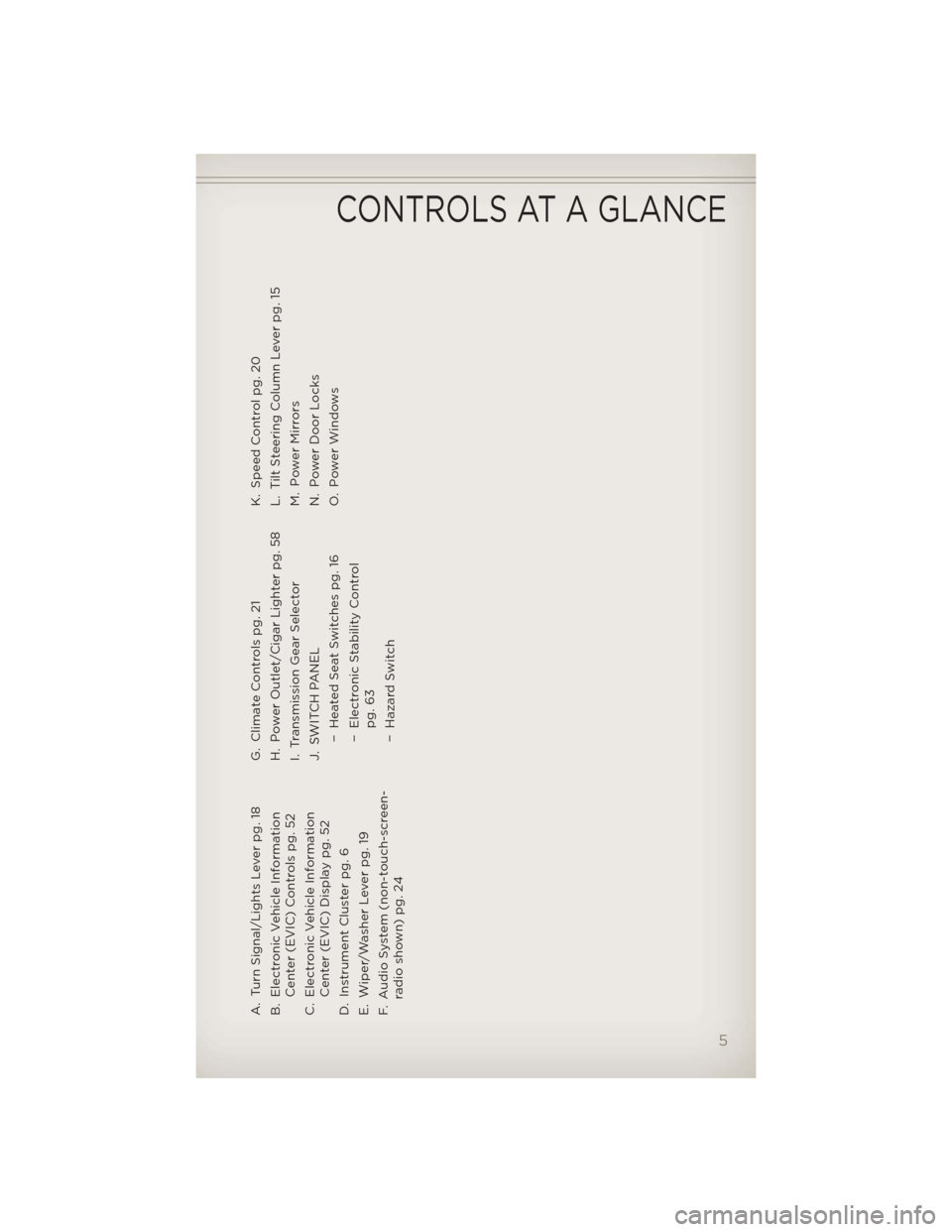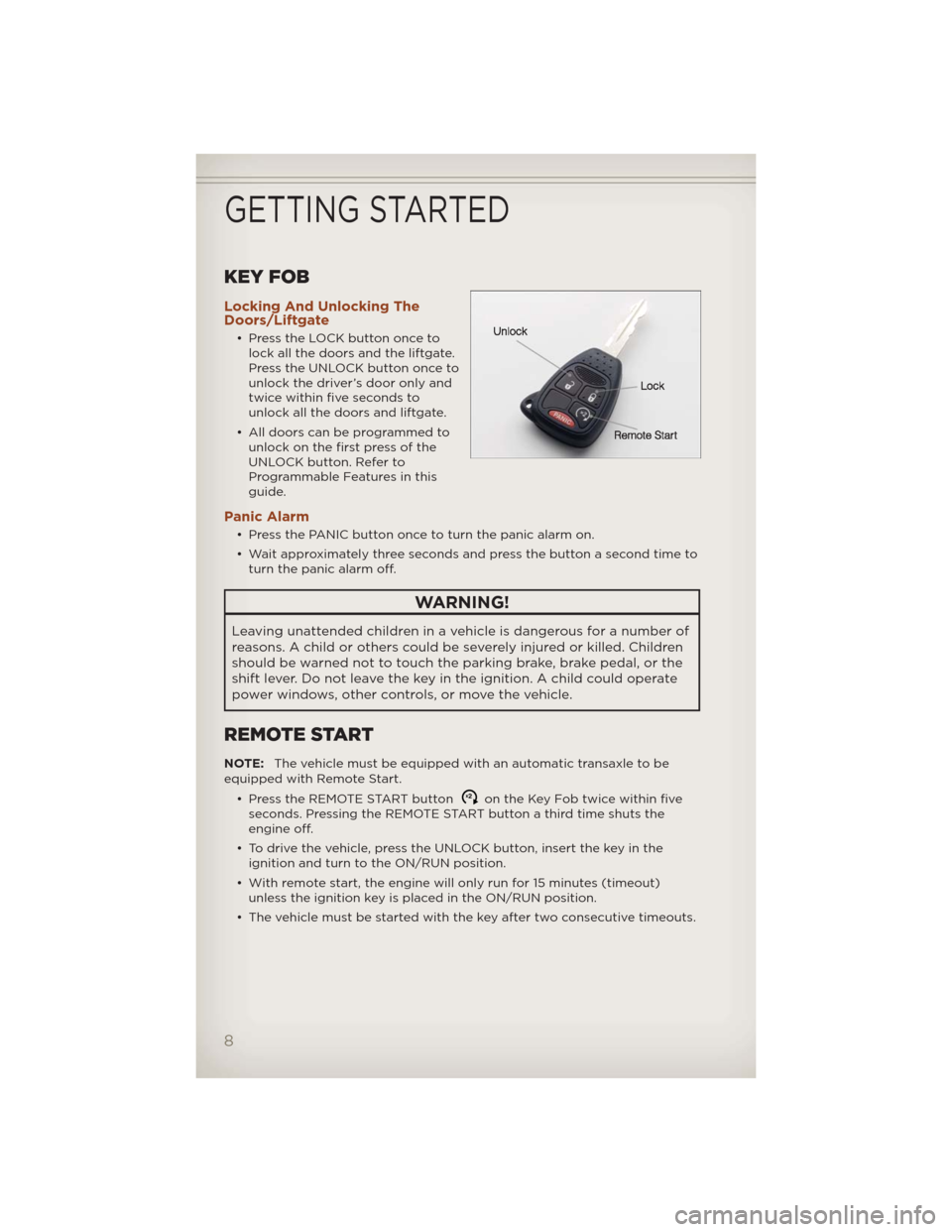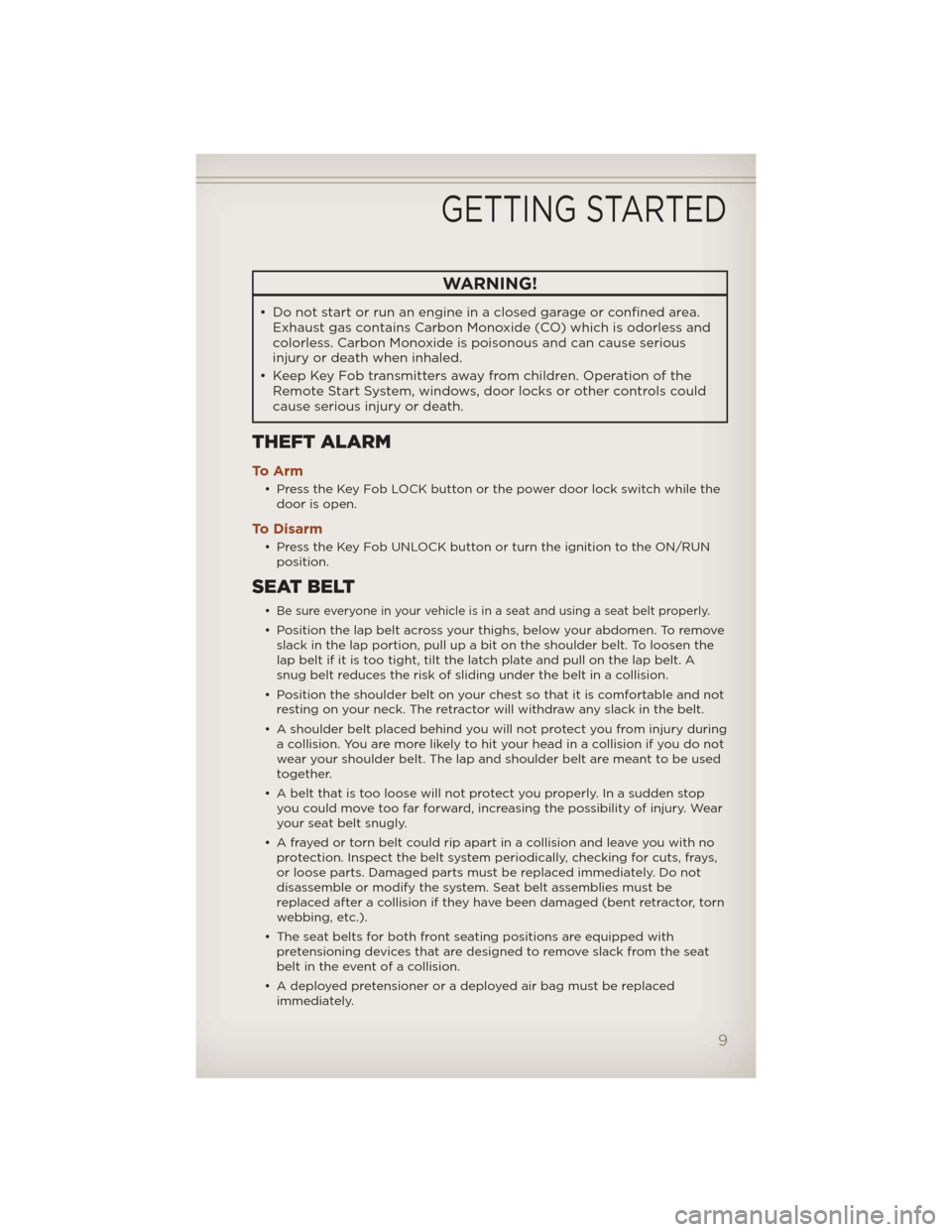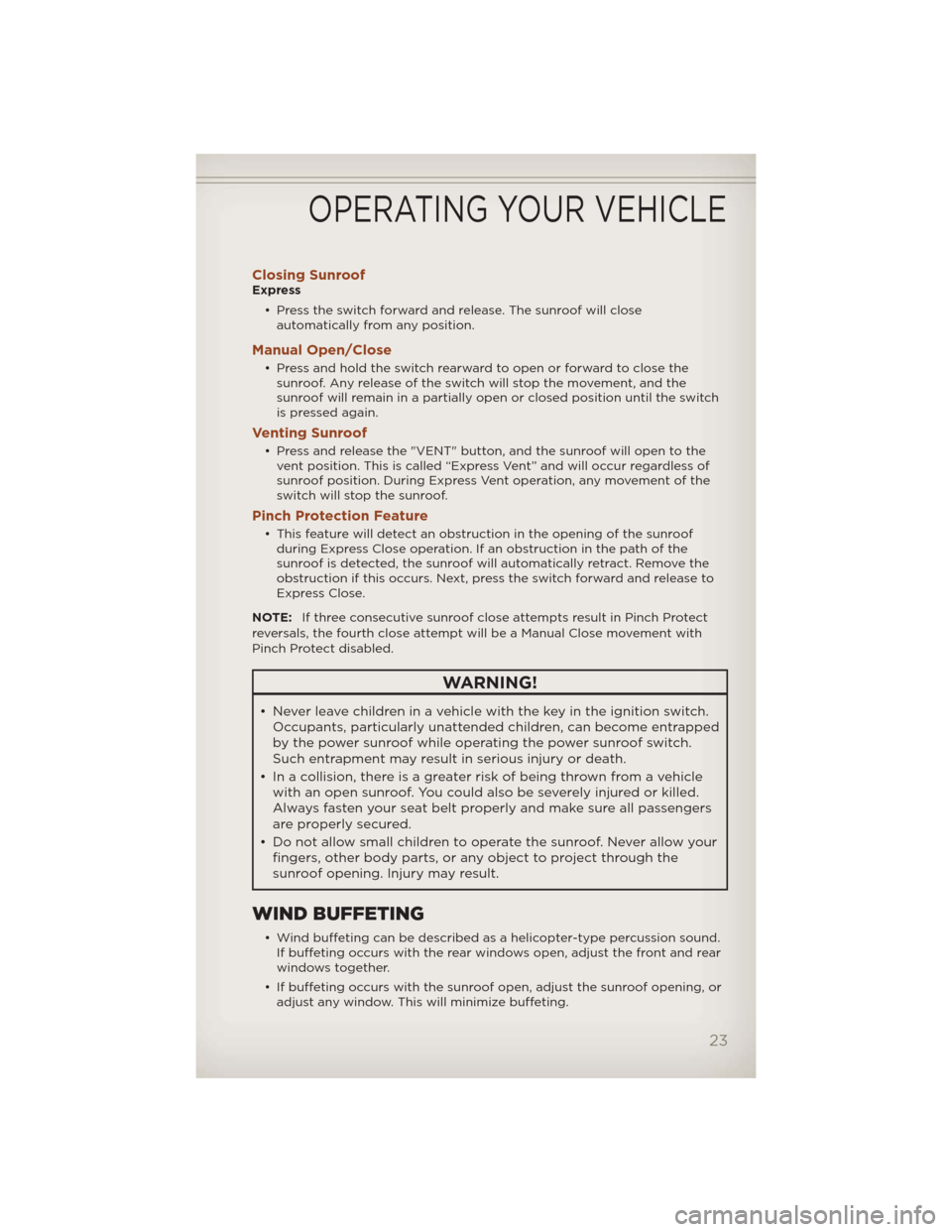Power windows JEEP COMPASS 2012 1.G User Guide
[x] Cancel search | Manufacturer: JEEP, Model Year: 2012, Model line: COMPASS, Model: JEEP COMPASS 2012 1.GPages: 108, PDF Size: 4.03 MB
Page 7 of 108

A. Turn Signal/Lights Lever pg. 18
B. Electronic Vehicle Information
Center (EVIC) Controls pg. 52
C. Electronic Vehicle Information
Center (EVIC) Display pg. 52
D. Instrument Cluster pg. 6
E. Wiper/Washer Lever pg. 19
F. Audio System (non-touch-screen-
radio shown) pg. 24G. Climate Controls pg. 21
H. Power Outlet/Cigar Lighter pg. 58
I. Transmission Gear Selector
J. SWITCH PANEL
− Heated Seat Switches pg. 16
− Electronic Stability Control
pg. 63
− Hazard SwitchK. Speed Control pg. 20
L. Tilt Steering Column Lever pg. 15
M. Power Mirrors
N. Power Door Locks
O. Power Windows
CONTROLS AT A GLANCE
5
Page 10 of 108

KEY FOB
Locking And Unlocking The
Doors/Liftgate
• Press the LOCK button once to
lock all the doors and the liftgate.
Press the UNLOCK button once to
unlock the driver’s door only and
twice within five seconds to
unlock all the doors and liftgate.
• All doors can be programmed to
unlock on the first press of the
UNLOCK button. Refer to
Programmable Features in this
guide.
Panic Alarm
• Press the PANIC button once to turn the panic alarm on.
• Wait approximately three seconds and press the button a second time to
turn the panic alarm off.
WARNING!
Leaving unattended children in a vehicle is dangerous for a number of
reasons. A child or others could be severely injured or killed. Children
should be warned not to touch the parking brake, brake pedal, or the
shift lever. Do not leave the key in the ignition. A child could operate
power windows, other controls, or move the vehicle.
REMOTE START
NOTE:The vehicle must be equipped with an automatic transaxle to be
equipped with Remote Start.
• Press the REMOTE START button
x2on the Key Fob twice within five
seconds. Pressing the REMOTE START button a third time shuts the
engine off.
• To drive the vehicle, press the UNLOCK button, insert the key in the
ignition and turn to the ON/RUN position.
• With remote start, the engine will only run for 15 minutes (timeout)
unless the ignition key is placed in the ON/RUN position.
• The vehicle must be started with the key after two consecutive timeouts.
GETTING STARTED
8
Page 11 of 108

WARNING!
• Do not start or run an engine in a closed garage or confined area.
Exhaust gas contains Carbon Monoxide (CO) which is odorless and
colorless. Carbon Monoxide is poisonous and can cause serious
injury or death when inhaled.
• Keep Key Fob transmittersaway fromchildren. Operation of the
Remote Start System, windows, door locks or other controls could
cause serious injury or death.
THEFT ALARM
To A r m
• Press the Key Fob LOCK button or the power door lock switch while the
door is open.
To Disarm
• Press the Key Fob UNLOCK button or turn the ignition to the ON/RUN
position.
SEAT BELT
•Be sure everyone in your vehicle is in a seat and using a seat belt properly.
• Position the lap belt across your thighs, below your abdomen. To remove
slack in the lap portion, pull up a bit on the shoulder belt. To loosen the
lap belt if it is too tight, tilt the latch plate and pull on the lap belt. A
snug belt reduces the risk of sliding under the belt in a collision.
• Position the shoulder belt on your chest so that it is comfortable and not
resting on your neck. The retractor will withdraw any slack in the belt.
• A shoulder belt placed behind you will not protect you from injury during
a collision. You are more likely to hit your head in a collision if you do not
wear your shoulder belt. The lap and shoulder belt are meant to be used
together.
• A belt that is too loose will not protect you properly. In a sudden stop
you could move too far forward, increasing the possibility of injury. Wear
your seat belt snugly.
• A frayed or torn belt could rip apart in a collision and leave you with no
protection. Inspect the belt system periodically, checking for cuts, frays,
or loose parts. Damaged parts must be replaced immediately. Do not
disassemble or modify the system. Seat belt assemblies must be
replaced after a collision if they have been damaged (bent retractor, torn
webbing, etc.).
• The seat belts for both front seating positions are equipped with
pretensioning devices that are designed to remove slack from the seat
belt in the event of a collision.
• A deployed pretensioner or a deployed air bag must be replaced
immediately.
GETTING STARTED
9
Page 25 of 108

Closing SunroofExpress
• Press the switch forward and release. The sunroof will close
automatically from any position.
Manual Open/Close
• Press and hold the switch rearward to open or forward to close the
sunroof. Any release of the switch will stop the movement, and the
sunroof will remain in a partially open or closed position until the switch
is pressed again.
Venting Sunroof
• Press and release the "VENT" button, and the sunroof will open to the
vent position. This is called “Express Vent” and will occur regardless of
sunroof position. During Express Vent operation, any movement of the
switch will stop the sunroof.
Pinch Protection Feature
• This feature will detect an obstruction in the opening of the sunroof
during Express Close operation. If an obstruction in the path of the
sunroof is detected, the sunroof will automatically retract. Remove the
obstruction if this occurs. Next, press the switch forward and release to
Express Close.
NOTE:If three consecutive sunroof close attempts result in Pinch Protect
reversals, the fourth close attempt will be a Manual Close movement with
Pinch Protect disabled.
WARNING!
• Never leave children in a vehicle with the key in the ignition switch.
Occupants, particularly unattended children, can become entrapped
by the power sunroof while operating the power sunroof switch.
Such entrapment may result in serious injury or death.
• In a collision, there is a greater risk of being thrown from a vehicle
with an open sunroof. You could also be severely injured or killed.
Always fasten your seatbelt properly and make sure all passengers
are properly secured.
• Do not allow small children to operate the sunroof. Never allow your
fingers, other body parts, or any object to project through the
sunroof opening. Injury may result.
WIND BUFFETING
• Wind buffeting can be described as a helicopter-type percussion sound.
If buffeting occurs with the rear windows open, adjust the front and rear
windows together.
• If buffeting occurs with the sunroof open, adjust the sunroof opening, or
adjust any window. This will minimize buffeting.
OPERATING YOUR VEHICLE
23